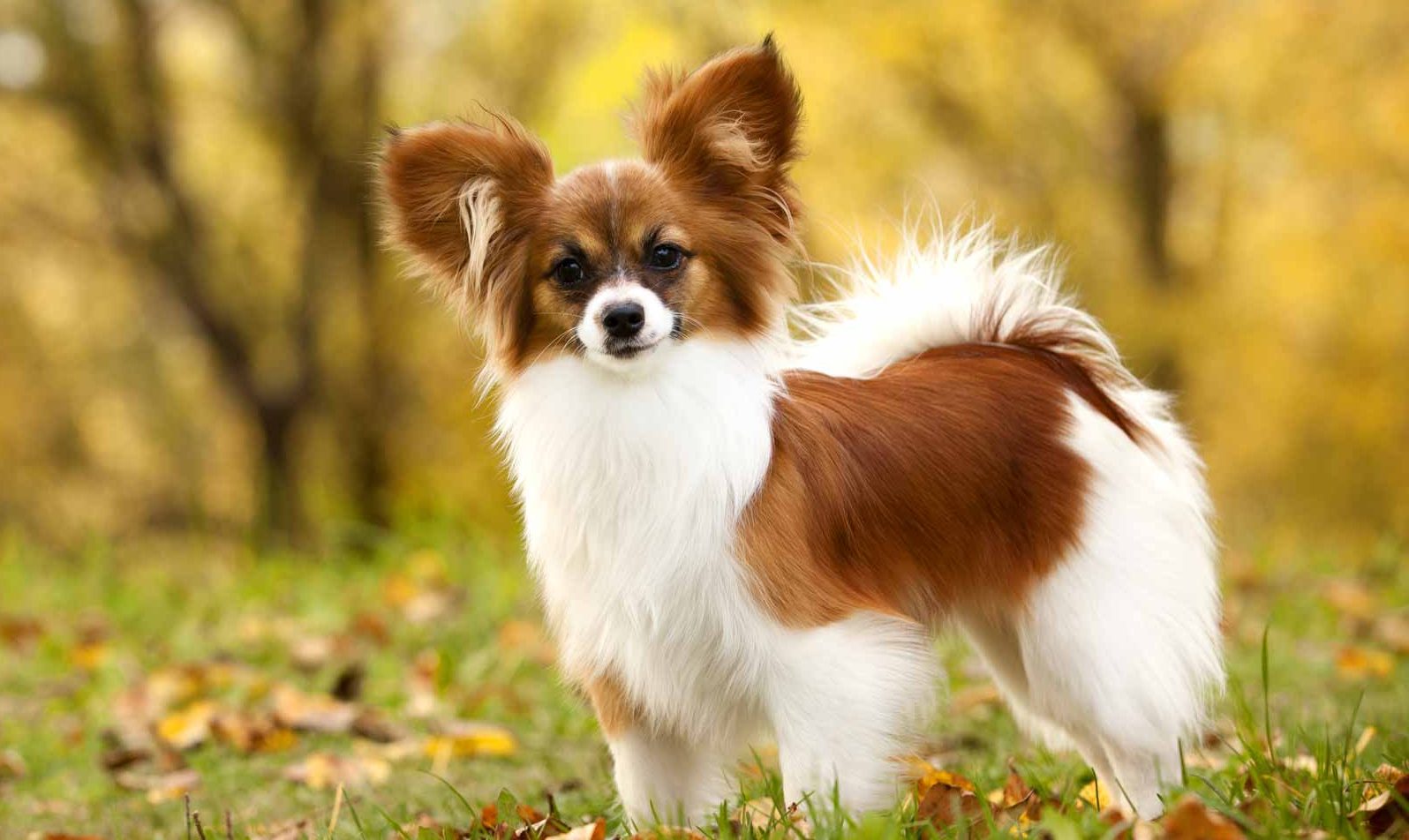-
Activity Level:
moderate
-
Shedding Level:
low
-
Grooming Level:
moderate
-
Trainability:
high
-
Good for Novice Owners:
high
-
Adaptability:
high
-
Kid/Pet Friendly:
often
-
Prey Drive:
low
-
Watchdog:
aware
- Average Size: Small
- Average Lifespan: 14-16 years
- Registered?: aca, akc, other
Papillon Dog Breed Information
Overview
Temperament
Adaptability
Health
Owner Experience
Grooming
Activity Level
Size
Life Span
Did You Know?
The Papillon, sometimes affectionately referred to as a Pap, originated hundreds of years ago in Europe. They were originally bred to be noble companions and were prized for their elegant appearance, small size, and charming personality.
One of the facts about the Papillon is that the breed has strong connections to France, Italy, and Spain. Although the breed has a strong connection to the French, early breeding centers in Italy and Spain are credited with refining the breed and helping it to become more popular. The AKC recognized the Papillon in 1915, and they are a member of the Toy Group.
Papillons are small, alert dogs with a hard constitution, a happy disposition, and a friendly nature. They’re known for their oversized bat-like ears and playful, comedic personality. Not only are these dogs loving and affectionate, but they are also natural charmers. Well-socialized, they get along well with children, other dogs, and other pets. They’re even considered one of the best dog breeds for cats.
They do tend to be a better fit for families with older children, as their tiny size, especially as puppies, makes them particularly susceptible to injury from the accidental falls or rough play that can be common with younger children. Any interactions between kids and puppies should be supervised to help avoid potential injury to your Pap.
There are big responsibilities that come with owning little dogs, and it’s important to make sure everyone in the family is prepared to handle them with a Papillon puppy. These little dogs will also bark to alert you when necessary, but don’t tend to be prone to barking excessively unless they have been trained into it.
It’s not a bad idea to train your dog to stop barking early on to keep it from becoming excessive as they grow. Well-socialized, they tend to be open with strangers, especially once they are introduced. After all, to a Pap, a stranger is just one more person who can shower them with attention and affection.
The Papillon is a highly adaptable dog breed. Their small size and moderate exercise requirements make them one of the dog breeds that are great in an apartment. And, even though they are small dogs, they are at home in larger homes as well. They do well in just about any setting and climate. As with most dog breeds, they are sensitive to extreme heat or cold.
They will happily chase after squirrels, insects, and even larger animals, so you will want to make sure they are in a securely fenced area if they are let off-leash. Paps are also true companion breeds that thrive on human attention and affection. As such, they do not like to be left alone for long periods of time.
Although the Papillon is a generally healthy and hardy dog breed, they are a tiny dog. Just as giant dog breeds have their specific health conditions, very small dogs do as well. Small dogs can be prone to heart problems, eye issues, and dental disease.
Potential health concerns to be aware of in Papillons, in particular, can also include patellar luxation and a soft spot in the top of the skull, which is called a fontanel. Good breeding practices and the health of the parents make a big difference in the health of Papillon puppies.
Responsible and reputable dog breeders will screen for these health conditions to avoid passing them to puppies. So, don’t be afraid to ask the breeder about the history of the parents and to see any relevant health clearances or test results. The Papillon Club of America recommends a cardiac exam, an ophthalmologist evaluation, and a patella evaluation.
The Papillon is one of the smartest dog breeds and is a highly trainable breed. They are intelligent and eager to please their humans, so they tend to pick up on things quickly. Although small breeds are notoriously difficult to housetrain, the Papillon tends to be a little better relative to other toy breeds. Having a few house training tips to help potty train your puppy on hand can help set you and your Papillon up for housetraining success.
They respond best to positive training methods focused on praise and reward, and are one of the best dog breeds for first-time owners. Early socialization and training are important for every dog breed. For the Papillon, it’s important to also avoid overpampering or overindulging your pup, as that often results in undesirable behaviors and a Pap that doesn’t listen.
Although the Papillon tends to have a longer coat, they do not need as much grooming as some other long-haired breeds. They will shed a low to moderate amount year-round, with a slight increase as the seasons change. They do not have an undercoat, so professional grooming sessions, or grooming sessions at home, every month are sufficient for them.
That, in addition to weekly brushing and a bath every few months as needed, will help keep your Pap’s coat clean and healthy. When brushing your Papillon, pay close attention to the fur behind their ears, inside the hind legs, and on their thighs, also called “culottes”, as these areas tend to tangle and are more prone to forming mats.
In addition to coat care, you will also need to care for your Papillon’s nails, ears, and teeth. Usually, once or twice monthly nail trimming is sufficient to keep your dog’s nails from growing too long and causing discomfort. A Pap’s nails tend to grow quickly and may need to be trimmed more often. You will want to pay special attention to their dewclaw. If left to grow, it will continue to curl around towards the leg as it grows. Lengthy nails are uncomfortable and painful for your dog as is, but a dewclaw that is too long can pierce the leg.
Regularly checking your dog’s ears on a weekly basis and carefully cleaning them as needed to make sure they are free of debris, clean, and dry can help prevent ear infections. You also want to make sure you implement good dental care for dogs. As a small dog breed, your Papillon will be more prone to developing dental diseases later in life, like gum disease and tooth decay. By brushing their teeth or using an enzyme toothpaste every day, you can help reduce the tartar and plaque buildup that leads to painful dental disease. Your efforts, plus regular checkups and cleanings with your vet, can help keep your Pap’s mouth healthy.
Although the Papillon is considered a toy breed, they are one of the most athletic toy breeds and has a moderate activity level. With sporting spaniels in their ancestry, this dog breed can often be found competing in agility trials, obedience, and other activities.
This means that they will be happy with their daily walks and playtime with you, but will also often be up for more activity as well. Just make sure to keep activities low-impact until puppies finish growing to avoid damage to developing bones and joints.
A fully-grown Papillon usually stands 8-11 inches tall at the shoulder and weighs 5-10 pounds. This makes them one of the smallest dog breeds.
A Papillon generally lives for 14-16 years on average.
All Papillons have large, wing-shaped ears, but some Papillons have ears that stick up, while others have ears that naturally flop down. Papillons with ears that are naturally down are known as Phalene-type Papillons.
The Papillon was favored by several famous figures of history, including Louis XIV, Madame de Pompadour, Marie Antoinette, and several European artists. The breed showed up in royal portraits painted by Rembrandt, Goya, and more.








